- This photo feature lists key Sanatan,
Buddhist, Jain Caves across India, period made and links to cave albums.
India’s rock cut cave architecture have always amazed me so decided to compile this piece.
Introduction
Writing for eSamskriti the late Vimla Patil ji said, “Dr. Usha Bhatia,
who has done extensive research in the history of art and Hindu monastic
establishments in the Shivalik Hills and the Himalayas, throws interesting
light on our heritage sites! (Prof. Bhatia has
obtained her MA in history of art from the Chandigarh University. She completed
her PhD under the guidance of Dr. B N Goswami).
“Cave monasteries were originally built as habitats for monks and sanyasis,” says Dr. Usha Bhatia, who worked at the National Gallery of Modern Art in Mumbai, “These men and women who had given up the life of the householder, needed solitude, peace and a conducive environment to meditate or learn the texts of their religion under masters. Therefore, they chose to make their dwellings far from human settlements. In the Ashokan period, Buddhism became the state religion of the Maurya Empire in the 3rd
century BC. Earlier to this, wooden dwellings were built for monks but they
were not strong. During this period, the monks moved to the Western Ghats because the rocks of these hills were most
suitable for carving out cave monasteries. Even today, this area of Maharashtra, with more than 2000 caves, is the world’s richest cave monument area of the world.”
“The earliest caves carved by Buddhist monks belonged to the Hinayana Buddhist path. In this style of architecture, which prevailed from 200 BC to 200 AD, only symbols
of the Buddha were used (no murty). After this era, Mahayana Buddhism flourished in India and the cave temples made in this period showed the Buddha in many poses. The idol of Buddha became a major feature of all temples of this period. The caves at Karla – which boast the single largest cave hall with well-formed pillars and an ornate entrance in the world – are one of the best examples of Hinayana cave architecture. While there are figures of human beings, celestial beings and animals on the entrance arch and the walls and designs with animals on the rounded columns, which allow the devotees to circumambulate the stupa, when Buddha was
represented only by the stupa.”
“Ajanta and Ellora are also one of the most wonderful group of caves. While cave numbers 9 and 10 have horseshoe shaped gates and windows for light, they also have paintings and sculptures which are world treasures today. Caves number 12 and 13 are viharas and chaityas. Caves 15 to 20 are the most beautiful. Caves 21 to 26 come in the third phase of building these shrines. The caves in Kanheri near Mumbai belong to the 10th century AD. Some of them have only a stupa which Hindus have traditionally thought to be a Shivling. Kanheri caves are also important for the development of the ornate pillars in Buddhist caves. The Mahakali caves near Mumbai are Buddhist in origin. There are also the Lonar caves near Kalyan and Bhiwandi. The Mandapeshwar and Jogeshwari caves-108 in number – are Hindu. Cave number 67 among these is important.”
Besides above, there are Jain Rock-Cut in
Gwalior Fort, Udaygiri Caves near Bhubaneshwar, Dharashiv and Pandavleni
(Nasik). Elephanta (Mumbai), Bojjannakonda and Lingalakonda in Andhra Pradesh,
Masrur Rock-cut Temples near Kangra, Badami in Karnataka, Sana and Talaja etc.
in Gujarat. In Mahabalipuram too are carvings out of rocks, though they cannot
be called caves.
This photo feature provides information in
brief with pictures.
1. Elephanta near Mumbai Saivite Source MTDC
Caves are on an island, about two hours boat ride from Mumbai’s Gateway of India. They are dating back to the 2nd
century, others say 6-8th century.
There are seven and are essentially Shaivite.
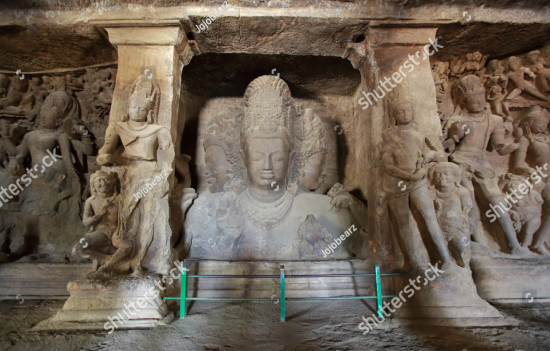 Caves famous for Trimurthi.
Caves famous for Trimurthi.
To know about Caves To see album Elephanta Festival
2. Kanheri in Mumbai Buddhist Source MTDC

It was founded by monks from Sopara (current
Nalasopara) in the 1st century BCE and flourished till the 10th
century. It is part of modern day Borivali National Park.
“Kanheri was surrounded by numerous trade centers and port cities linked to the Silk route in central Asia. The inscriptions at Kanheri provide details of patrons, names of Kings, their family members, ministers, administrative officers, traders, monks and nuns who have given extensive donations. The donations were made to excavate caves, built temples, create reservoirs and water cisterns.”
3. Karla near Lonavla in Pune district Buddhist
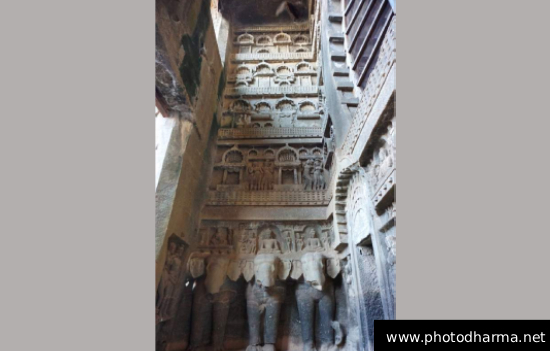 Verandah left side.
Verandah left side.
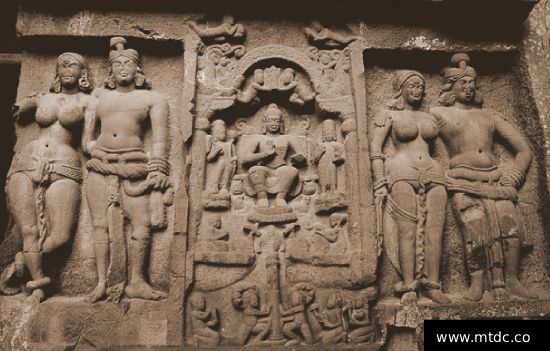 Centre is Buddha.
Centre is Buddha.
“Karla Caves are one the oldest Buddhist monuments constructed between the 2-5th Century AD. These caves represent the highest achievement of rock-cut architecture of the time and the earliest examples of ornate and richly decorated temples in India. The most popular aspect of the caves is the Grand Chaitya or one of the largest Chaityagrihas-a Buddhist prayer hall, which showcases some of the most intricate artwork.” Source
MTDC
Since the prayer hall has
only a stupa the period made could be 50 BC to 150 AD. 1 Pg 516 Outside of
the hall are Buddha images, these might be added later.
To see a very good album on Karla Caves
4. Bhaja near Lonavla in Pune district - Buddhist
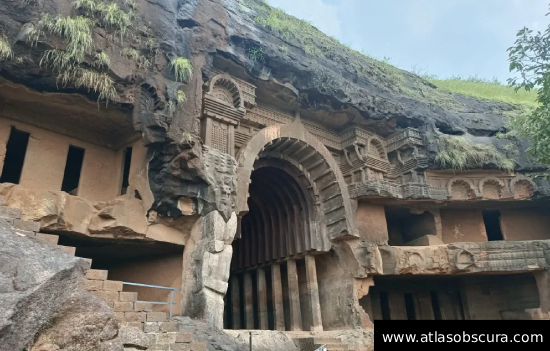 Entrance to main cave.
Entrance to main cave.
 Lord Indra. Pic by Benoy K Behl
Lord Indra. Pic by Benoy K Behl
“The caves belong to the Theravada (Hinayana) tradition of Buddhism and are amongst the oldest in Western India. They are approx 400 ft above the village of Bhaja, used as an important ancient trading route that ran from the Arabian Sea eastward into the Deccan plateau. This route is the 'Bhor Ghat', a strategic mountain pass that connects the Deccan to the ports of the Konkan coast.
The sole 'Chaityagriha' (prayer hall) at this site is considered extraordinary in comparison to any site. It is one of the earliest rock-cut chaitya griha in Maharashtra. It has 27 pillars around the hall with wooden beams fixed on its ceiling. The cave had a horseshoe arched entrance with a wooden facade. Apart from this Chaityagriha, the complex of Bhaja caves is full of rock-cut Vihara and Stupas.” Source
MTDC Period 50 BC to 150 AD. 1
Pg 516
Pic from this album For a write up on and pictures of caves
5. Bedse near Lonavla in Pune district – Buddhist
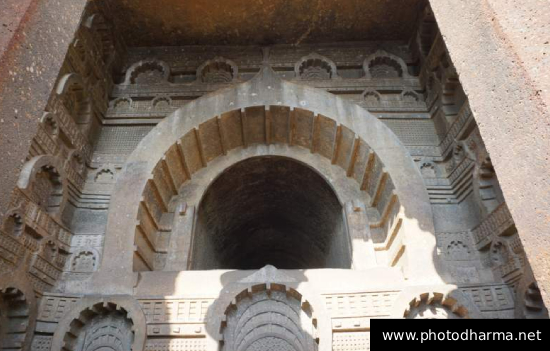 Chaitya
Hall Frontage. Pic by Photodharma.net
Chaitya
Hall Frontage. Pic by Photodharma.net
“The Bedse Caves date back to the 1st century BCE and were carved out of the rocky hillsides during the Satavahana (Hindu rulers) period. They are believed to have been used by Buddhist monks as places of meditation and religious activities. The caves showcase a blend of architectural styles,
reflecting the influence of both Buddhism and Hinduism.” Source
MTDC To see album
6. Dharashiv near Nasik – Buddhist and Jain

“The Dharashiv Caves, also known as Dharashiv Leni, are a group of Buddhist caves located in Osmanabad district, Maharashtra, India. The Dharashiv Caves are around 8 kilometers (5 miles) from the town of Osmanabad in Maharashtra, India. They are nestled in the hills of the region. The caves are a complex consisting of around 14 rock-cut Buddhist caves. The caves are believed to be excavated during the 8th to 9th centuries. They show case the influence of both Hinayana and Mahayana Buddhism. The architecture of the caves is relatively simple compared to others. Each cave has its own unique features. Some of the notable caves include Cave 6, which has a large sculpture of Buddha seated in the preaching posture, and Cave 7, which features a large image of Buddha in a seated position along with other smaller sculptures. The Dharashiv Caves hold historical and archaeological significance, as they provide insights into the Buddhist culture and art prevalent during that time in the region.” Source
MTDC
7. Pandavleni near Nasik - Buddhist
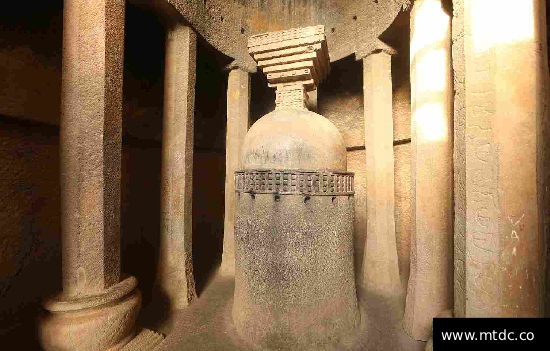
“The caves are situated on the Trirashmi Hills and consist of a total of 24 caves, carved out of the basalt rock. These caves were originally used as viharas (monasteries) and were a place of meditation and religious activities for Buddhist monks. The name "Pandavleni" comes from a popular belief that the Pandavas, stayed in these caves during their exile.
The architecture of the Pandavleni Caves reflects the
influence of the Hinayana and Mahayana Buddhist traditions. The caves feature
intricate carvings, sculptures, and inscriptions depicting various Buddhist
deities, scenes from the life of Buddha, and other mythological figures. The
main cave, known as Cave 3, is the largest and most impressive, featuring a
majestic entrance and a grand chaitya (prayer hall) with beautiful carvings.” Source
MTDC
Since I have been to Ellora and Ajanta can
explain better. Ellora has Buddhist, Saivite and Jain caves (all co-existed for
centuries) of which the Kailasa Temple, Ellora is most famous.
8. Ellora Buddhist (information of dates is as per ASI board outside temple)
Cave 10 -7th century. Locally
called Visvakarma Cave.
Cave 2 -8th century.
Cave 4 –period not known.
Cave 5 - 7th century. Maharvada
Cave.
Cave 12 -8th century. 3 storey.
Cave 6/7 -period not known.
Cave 11 –Two storey.
Cave 1 –period not known.
 Cave
10.
Cave
10.
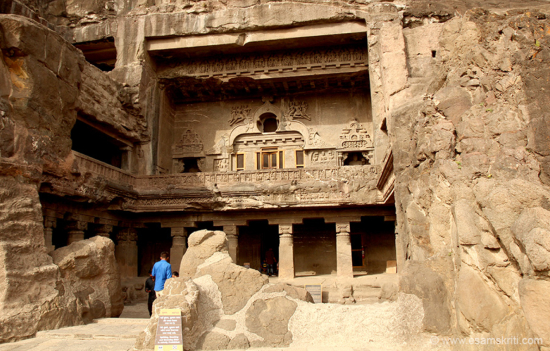 Entrance to cave no 10.
Entrance to cave no 10.
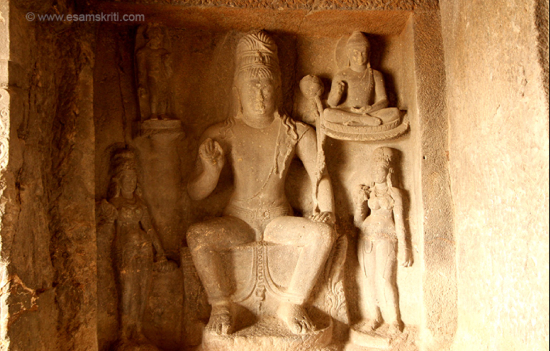 Cave 4. Padmapani accompanied by Tara and Chuda.
Cave 4. Padmapani accompanied by Tara and Chuda.
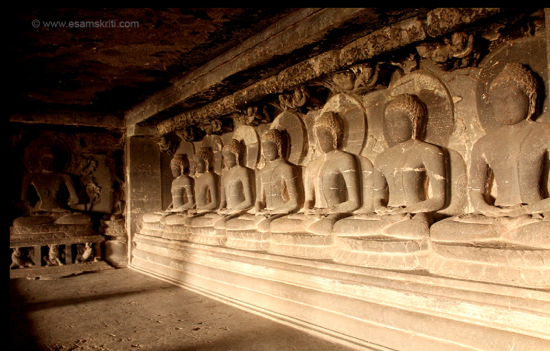 Cave 12. Seven Dhyani Buddha.
Cave 12. Seven Dhyani Buddha.
To see pics arranged by Cave number Exhaustive coverage by Photodharma.net
9. Ellora Saivite
P Cave 29. Siva and Parvati sitting on Mount Kailash with Ravana trying to
shake the holy mountain.
 Nandi outside Cave 21.
Nandi outside Cave 21.
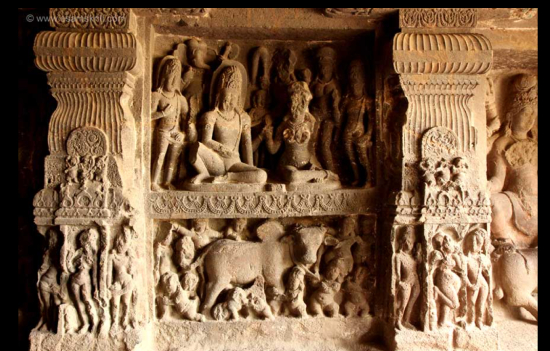 Shiva Parvati playing dice. Cave 14 known as ‘Ravan ki Khai’.
Shiva Parvati playing dice. Cave 14 known as ‘Ravan ki Khai’.
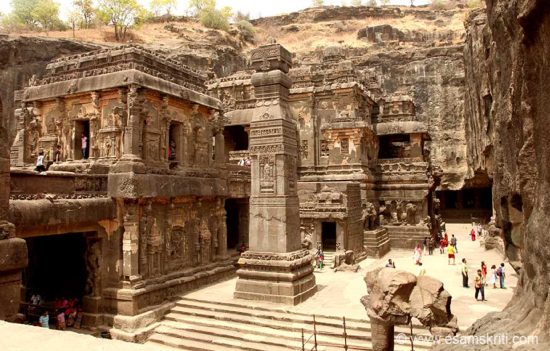 Kailasa Temple – side view. Cave 16 datable to 8th century.
Kailasa Temple – side view. Cave 16 datable to 8th century.
 View from top of hill.
View from top of hill.
To see albums cave no 29 , other Saivite caves (22,21,14,15) and Kailasa Temple.
10. Ellora Jain – cave 32 datable 10-11th century
P Cave is said to be replica of Kailash Temple, albeit smaller in scale.
11. Ajanta near Chhatrapati Sambaji Nagar
Cave 1 HELP
Cave 2 6-7th century A.D.
 Overview of caves.
Overview of caves.
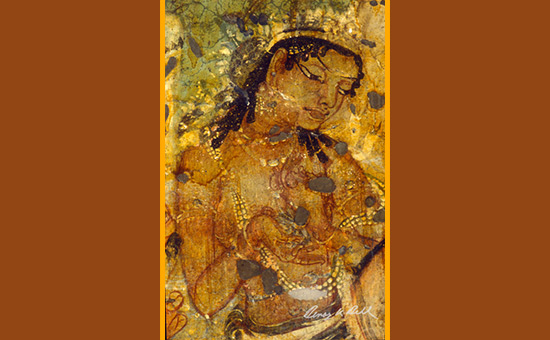 Cave 1. Pic by Benoy K Behl.
Cave 1. Pic by Benoy K Behl.
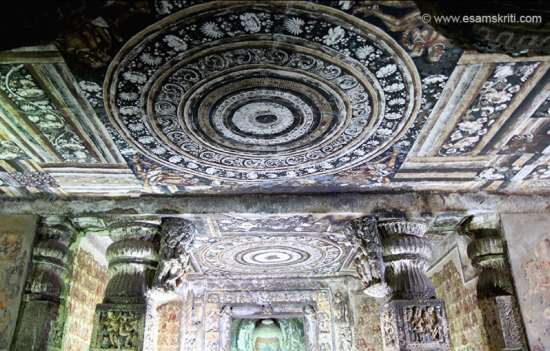 Cave 2.
Cave 2.
To
see album Caves 1 and 2
Cave 4 6th century A.D
Cave 6 HELP
Cave 7 HELP
Cave 9 Chaityagriha belongs to 1st century B.C. Some paintings 5-6h century A.D
Cave10 2nd century B.C. Paintings belongs to 1st century B.C.
and 4th A.D.
Cave 11 HELP
Cave 19 End of 5th century a.d.
To
see albums caves 4,6,7,9,10,11,19
Cave 16 Excavation 475 to 500 A.D.
Cave 17 Excavation 475 to 500 A.D.
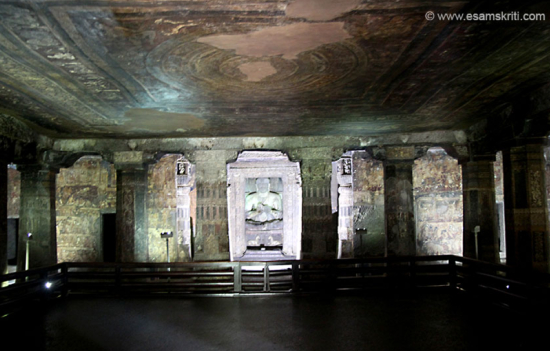 Cave 17.
Cave 17.
 Cave 16.
Cave 16.
To see albums
caves 16 and 17
Cave 20 Excavation 450 to 525 A.D.
Cave 21 Excavation 6th century A.D.
Cave 24 Excavation 7th century A.D.
Cave 26 HELP
P Sleeping Buddha at end. Side panel of cave 24.
To see album caves
20,21,24,26
12. BADAMI caves, Karnataka
There
are five caves. 1st is Shiva, 2nd is Vishnu, 3rd
is Buddha, 4th is Mahavishnu and 5th is Jain. Badami was
capital of the Chalukyas from 6-8th century A.D.
Cave
1 excavated 550 A.D.
Cave
4 excavated 578 A.D.
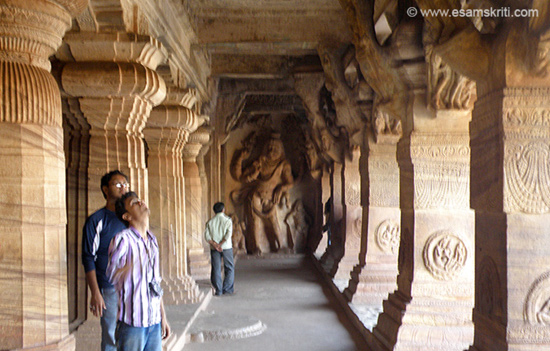 Mahavishnu in Badami caves.
Mahavishnu in Badami caves.
To see album
Badami
13.
Rock-cut Gwalior Fort – Jain
Carved
in the 15th century during the reign of Tomar king Dungar Singh.
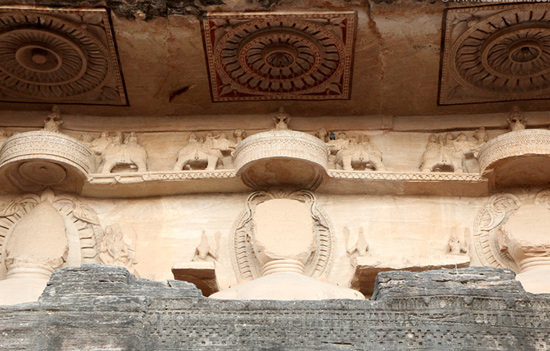 Images of Tirthankaras destroyed by Invaders probably Babur or Aurangzeb.
Images of Tirthankaras destroyed by Invaders probably Babur or Aurangzeb.
To
see album
14.
Udaygiri and Khandgiri caves, Odisha – Jain
Excavation
started in 1st century and carried on till 10-11th
century A.D.
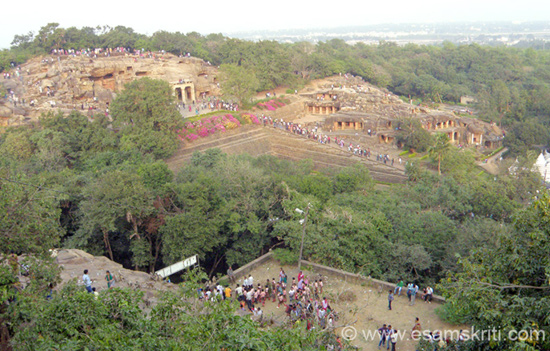 View of Udaygiri Hill. Caves were dwelling
retreats.
View of Udaygiri Hill. Caves were dwelling
retreats.
To
see album above
15.
Udaygiri Caves near Sanchi – Vaishnav
20
caves. Excavated during Gupta period 4-5th century, reign of
Chandragupta II
P Varaha avatar of Vishnu.
To see album
16. Bojjanna Konda Andhra Pradesh – Buddhist
Established
4-9th century A.D.
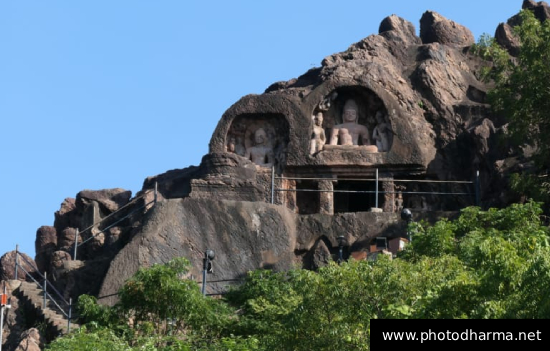 Overview. Buddha image.
Overview. Buddha image.
To see album
17.
Undavalli Caves Andhra Pradesh – Buddhist
Caves
claimed by Sanatanis, Buddhist and Jainas.
 The 4 storey structure is carved out of sandstone hill, reflects Gupta architectural styles
The 4 storey structure is carved out of sandstone hill, reflects Gupta architectural styles
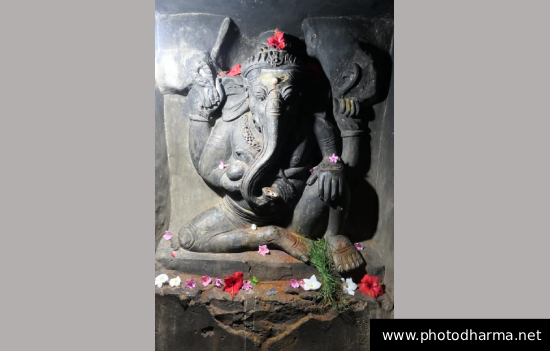 Ganesha.
Ganesha.
To see album
18. Masrur Rock-Cut Temples, Kangra – Sanatan
 Dated
750-770 A.D.
Dated
750-770 A.D.
To
read
write up and pictures
Based on an online search other caves are –
1.
Gujarat: Junagadh Buddhist Cave Groups: A group of caves in the Junagadh
district. Sana Caves: A group of 62 caves situated in the Gir Forest
region. Talaja Caves: Located in the Bhavnagar district. Siyot Caves: A
rock-cut cave complex in the Kutch district.
2. Karnataka - Gavi Gangadhareshwara Temple: A Shiva temple with a unique feature where the sun's rays pass through a hole in the rock to illuminate the deity during the Makara Sankranti festival, according to Wikipedia. Hulimavu Shiva cave temple: Another rock-cut Shiva temple. Narasimha Jharni: A cave temple in Gulbarga dedicated to Lord Narasimha, according to Wikipedia. Nellitheertha Cave Temple: A cave temple known for its underground stream, according to Wikipedia.
3.
Andhra Pradesh: Guntupalle Caves: Also
known as the Guntupalli Group of Buddhist Monuments, these are found near
Dwaraka Tirumala and are believed to pre-date even the Ajanta and Ellora caves.
Bodhikonda and Ghanikonda: Situated in Ramatheertham, these caves are
another significant Buddhist site. Akkanna Madanna Caves: Located in
Vijayawada, these are a group of caves carved out of a hill. Bhairavakona Caves: Hindu
temple caves found in the Prakasam district, carved into a hill.
Also read
1.
Indian Roots of Asia’s Buddhist Art by Benoy Behl
2.
For exhaustive albums on
Buddhist Monuments in India
3.
For Cave wise
eSamskriti albums on Ajanta and Ellora
4.
For albums
of Bodh Gaya, Buddhist Holy Places in India and Thailand
5.
Photographic
exhibition of Buddha in the World
6.
Lord
Indra in Buddhism
7.
How
Hindu/Buddhist strains are intertwined in Japan, Thailand, Cambodia